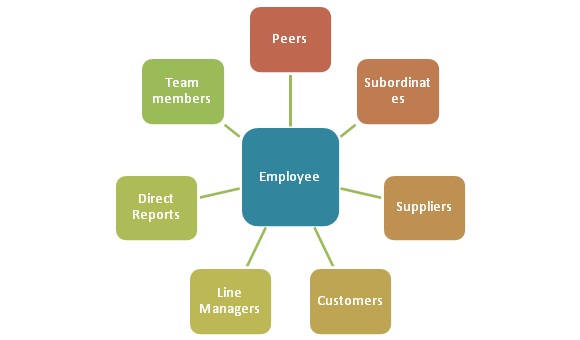360 degree feedback or assessment is a feedback system where an employee receives feedback from all the people around him related to business. In 360 degree feedback, a feedback about the employee is received from everyone with whom he has interacted with in the course of executing his job responsibilities. 360 degree feedback is obtained from peers, teammates, subordinates, direct reports and even external parties like suppliers and vendors.
360 Degree Feedback is a type of feedback which is done by managers to understand the performance of an employee, and used in the appraisal process. This feedback is a part of the organizational feedback which is intended to improve the quality of employees in the workforce.
Importance of 360 degree feedback
It is essential for an organization to evaluate the performance of its employees. If an employee is under performing, they must be warned and if they are doing well, they must be rewarded. This can be done by understanding their performances based on a feedback. This is why 360 degree feedback is important to an organization. This feedback may be used as an input to the performance appraisal process. It may also be used to identify competency gaps to administer relevant training to the employee.
This 360 degree feedback/assessment is also known as a multi-rater or multi source feedback as feedback about the employee is gathered from multiple sources and not just the reporting manager as in the case of a traditional performance appraisal system.

The above image shows the 360 degree feedback of an employee based on reviews from peers, subordinates, suppliers, customers, managers & other team members.
Advantages of 360 degree feedback
There are several advantages of 360 degree feedback. Some of the benefits of such a feedback system are as below
1. It helps in evaluating the overall performance of an employee
2. 360 degree feedback gives a complete view of the work the employee has done, and just based on some supervisors review
3. This feedback shows all the competencies of an employee across various domains and verticals of business
4. Based on 360 degree feedback, new training programs can help develop the employee even more
5. The employee can work on his or her shortcomings based on the feedback given by everyone
Disadvantages of 360 degree feedback
There are certain drawbacks of this type of a feedback system. Some disadvantages of 360 degree feedback are:
1. Favoritism can affect the feedback of certain employees who otherwise must be working well
2. 360 degree feedback mostly gives qualitative feedback and might overlook the quantitative performance of an employee
3. Unfair feedback from some people may lead to an ambiguous ratings of the employee's performance.